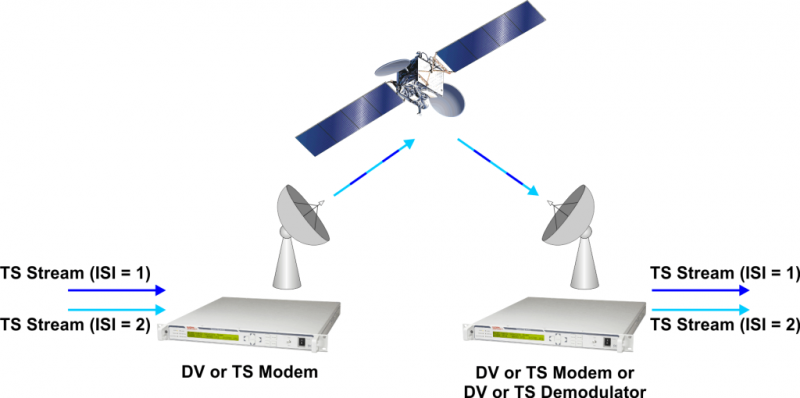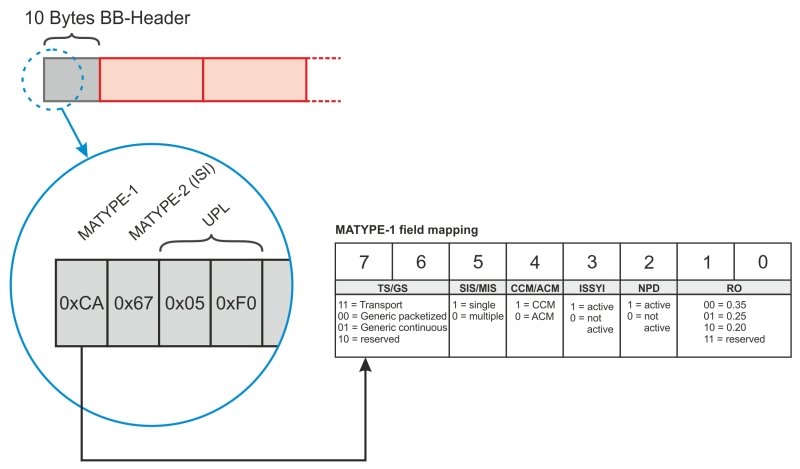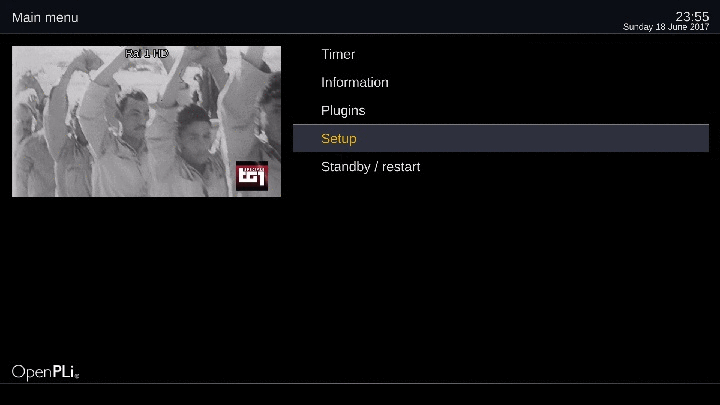Difference between revisions of "Multistream"
Rick Hunter (talk | contribs) |
|||
| Line 57: | Line 57: | ||
* The '''PLS mode''' can be Root, Gold or Combo.<br /> | * The '''PLS mode''' can be Root, Gold or Combo.<br /> | ||
* The '''PLS code''' can be 6 digits. Some Italian channels have code 8. Then you enter: 000008.<br /> | * The '''PLS code''' can be 6 digits. Some Italian channels have code 8. Then you enter: 000008.<br /> | ||
| + | |||
| + | '''==List of receivers current or upcoming with DVB-S2X / multistream capability==''' | ||
| + | * Octagon SF4008 with S2X tuner | ||
| + | * Gigablue all models (except gb7325) with the GIGA DVB-S2 NIM SP2246T (since driver update feb 2017) | ||
| + | * Mutant HD51 with optional S2X tuner (Available 06/2017) | ||
| + | * AX51 with optional S2X tuner (Available 06/2017) | ||
| + | * Gigablue all models with optional S2X tuner (In stock Q4 2017) | ||
| + | * Vu Uno 4k SE (In stock Q4 2017) Vu Uno 4k SE (In stock Q4 2017) | ||
| + | * Upgrade Vu Ultimo 4k should be possible but not yet confirmed when the Uno 4k se is available. | ||
| + | * Zgemma H5 Plus models | ||
| + | * Zgemma H7S Model | ||
| + | * Spycat 4K models (delivery date unknown) | ||
| + | * From August 2017 also DM900 / DM7080 / DM820 with optional tuner | ||
| + | Source: https://forums.openpli.org/topic/52120-new-tuner-si2166d-mutnt-51hd/page-2#entry740476 | ||
Revision as of 20:50, 17 July 2017
Introduction to DVB-S2 Multistream
The migration from DVB-S to DVB-S2 introduced significant enhancements not only on the signal side, but also related to content. One improvement that the DVB-S2 standard offers is multistream technology, which allows operators to transmit several transport streams or IP streams via one satellite carrier in a transparent way. As soon as more than one stream is transmitted or received, a multistream device replaces several single stream devices, thereby reducing equipment costs.
How it works:
Multistream technology includes a mechanism in the underlying baseband frame structure that merges multiple transport and generic data streams. The modulator uses only the packets of one stream to fill a baseband frame and starts a new one for the second stream. The frames are then aligned sequentially for transmission. Using an 8-bit identifier in the baseband frame header, also known as an input stream identifier (ISI), the baseband frames are designated to a specific stream. Up to 256 transport and/or IP streams can be merged.
On the basis of the ISI, the demodulator is capable of separating each stream but without any clock reference. The burst-wise output collides with the requirements of the program clock references (PCR), which is used in transport streams. These transport stream internal timestamps are used for video and audio timing and only allow a jitter of 100ns, a number that cannot be reached by simply averaging the FIFO level. In case of multiple transport streams (MTS), multistream technology provides a further mechanism to achieve correct PCR alignment after reception. The input stream synchronization (ISSY) can append a 2-byte or 3-byte ISSY field to each transport stream packet, which contains a timestamp to guarantee an end-to-end constant bit rate. To ensure the demodulator is in sync with the modulator, the symbol rate clock serves as the reference for these timestamps. The demodulator recovers this clock from the signal and, leveraging the ISSY timestamps, releases each packet toward the output interface at an exact predetermined point of time. The PCR jitter stays within the specification.
The additional data overhead can be eliminated by null packet deletion (NPD), another feature of multistream technology. Null packets are used to fill a transport stream to a certain constant data rate and do not contain any user data. Since the demodulator can recover the data rate through the ISSY, there is no need to transmit all of the null packets. With the enabled NPD feature, the modulator will delete up to 256 successive null packets and append a 1-byte counter value to each transport stream packet signalizing how many null packets have been removed before its position. After reception, the demodulator immediately reinserts the corresponding number of null packets when unpacking the transport stream from the baseband frames. Depending on the stream’s structure, a significant amount of additional bandwidth can become available through NPD. When used in combination with lower priority data like Web traffic, the signal is utilized in the most efficient way.
When it comes to notifying the demodulator about the adopted mode adaptation, each DVB-S2 baseband frame has a 10-byte baseband header, where the first byte MATYPE-1 contains the information about the content type. During the analysis of the baseband header, the demodulator has knowledge of whether ISSY and/or NPD were used in the modulator or what content is in the data field of the baseband frame. As already noted, the ISI is stored in the second byte (MATYPE-2 byte) of the baseband header.
Benefits of multistream technology:
With the introduction of DVB-S2 multistream technology, users can now combine multiple transport streams or digital data streams into a single satellite carrier, or a mix of both data types in the instance of DSNG. Furthermore, multistream offers several important user benefits. First, each stream is independently configurable with complete user control for choosing any number of streams. Second, multistream allows more features to be contained into a single device. Even externally fed baseband frames with proprietary content can be made part of the system, while still having traffic and signal control as part of the same device. Finally, by using a single satellite carrier, operators can realize significant savings in bandwidth costs.
Source: https://work-microwave.com/introduction-dvb-s2-multistream/
Although PLS and Multistream are two different techniques, you often see this combined. But they do not have any relation with each other. PLS was originally intended to reduce the cross-channel interference. But in real-live it is used as a simple encryption. Multistream is a part of DVB-S2. PLS is also, but then only with a reduced number of values can be used. Regularly the values are zero. With DVB-S2x you may choose the numbers.
Multistream with a enigma receiver:
Here some facts:
- Multistream is a Tuner feature (so any receiver with a pluggable tuner and multistream capable tuner can receive multistream)
- Multistream is currently enabled on develop branch. So it is not available with OpenPLi 4
In order to identify a multistream card we are queriying via DVB API 5.10 the existance of FE_CAN_MULTISTREAM. Once a tuner has above feature we are allowing IS (Input Stream - ISSY) and PLS (Physical Layer Scrambling) configuration.
There are tuners that support only Multistream but do not support PLS. Ther are tuners that support limited PLS (eg Combo on 30W is hard to get). Many multistream channels are available are on 5W and 12.5 W.
Multistream is a good candidate for S2X because of the gains on bandwitdh it provides, really required for wide adaption on 4K. Newer S2X tuners might include Multistream and PLS because it is described on eXtensions.
People with an Multistream tuner should know the MIS/PLS parameters or use a ready satellites.xml (eg http://satellites-xml.org/ mantained from Huevos contain already the required configuration)
Here is has some info about PLS (page 31) http://www.etsi.org/deliver/etsi_en/302300_302399/302307/01.02.01_60/en_302307v010201p.pdf and here: https://etrij.etri.re.kr/etrij/journal/article/pubreader.do?volume=36&issue=2&page=329&fileId=SPF-1395881349795
To receive a multi stream you must have a DVB-S2x tuner. E.g. the Zgemma H5.2S has one DVB-S2x tuner in the secondary slot - or - the HD51 with a separately sold DVB-S2x tuner.
Currently in Europe Multistream channels exists on Eutelsat 5 West (France and Italian Channels) and Eutelsat 12 West (Italian Channels).
- Input stream is a stream number that can have 3 digits. If the code is 2 then you enter: 002
- The PLS mode can be Root, Gold or Combo.
- The PLS code can be 6 digits. Some Italian channels have code 8. Then you enter: 000008.
==List of receivers current or upcoming with DVB-S2X / multistream capability==
- Octagon SF4008 with S2X tuner
- Gigablue all models (except gb7325) with the GIGA DVB-S2 NIM SP2246T (since driver update feb 2017)
- Mutant HD51 with optional S2X tuner (Available 06/2017)
- AX51 with optional S2X tuner (Available 06/2017)
- Gigablue all models with optional S2X tuner (In stock Q4 2017)
- Vu Uno 4k SE (In stock Q4 2017) Vu Uno 4k SE (In stock Q4 2017)
- Upgrade Vu Ultimo 4k should be possible but not yet confirmed when the Uno 4k se is available.
- Zgemma H5 Plus models
- Zgemma H7S Model
- Spycat 4K models (delivery date unknown)
- From August 2017 also DM900 / DM7080 / DM820 with optional tuner
Source: https://forums.openpli.org/topic/52120-new-tuner-si2166d-mutnt-51hd/page-2#entry740476


